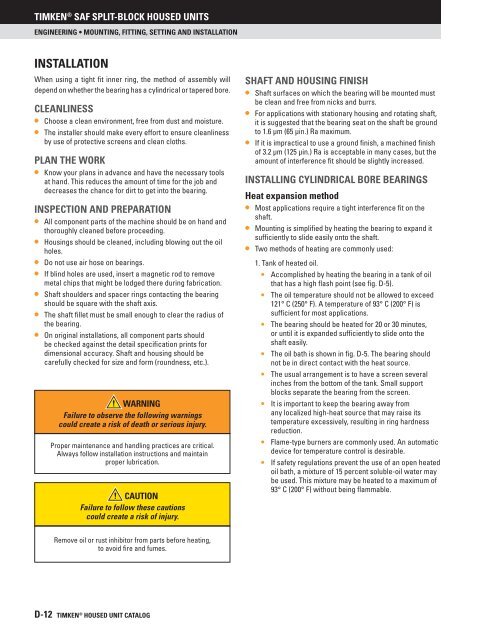Create successful ePaper yourself
Turn your PDF publications into a flip-book with our unique Google optimized e-Paper software.
<strong>Timken</strong> ® SAF SPLIT-BLOCK HOUSED UNITS<br />
Engineering • Mounting, Fitting, Setting and Installation<br />
Installation<br />
When using a tight fit inner ring, the method of assembly will<br />
depend on whether the bearing has a cylindrical or tapered bore.<br />
CLEANLINESS<br />
• Choose a clean environment, free from dust and moisture.<br />
• The installer should make every effort to ensure cleanliness<br />
by use of protective screens and clean cloths.<br />
PLAN THE WORK<br />
• Know your plans in advance and have the necessary tools<br />
at hand. This reduces the amount of time for the job and<br />
decreases the chance for dirt to get into the bearing.<br />
INSPECTION AND PREPARATION<br />
• All component parts of the machine should be on hand and<br />
thoroughly cleaned before proceeding.<br />
• Housings should be cleaned, including blowing out the oil<br />
holes.<br />
• Do not use air hose on bearings.<br />
• If blind holes are used, insert a magnetic rod to remove<br />
metal chips that might be lodged there during fabrication.<br />
• Shaft shoulders and spacer rings contacting the bearing<br />
should be square with the shaft axis.<br />
• The shaft fillet must be small enough to clear the radius of<br />
the bearing.<br />
• On original installations, all component parts should<br />
be checked against the detail specification prints for<br />
dimensional accuracy. Shaft and housing should be<br />
carefully checked for size and form (roundness, etc.).<br />
WARNING<br />
Failure to observe the following warnings<br />
could create a risk of death or serious injury.<br />
Proper maintenance and handling practices are critical.<br />
Always follow installation instructions and maintain<br />
proper lubrication.<br />
CAUTION<br />
Failure to follow these cautions<br />
could create a risk of injury.<br />
SHAFT AND HOUSING FINISH<br />
• Shaft surfaces on which the bearing will be mounted must<br />
be clean and free from nicks and burrs.<br />
• For applications with stationary housing and rotating shaft,<br />
it is suggested that the bearing seat on the shaft be ground<br />
to 1.6 µm (65 µin.) Ra maximum.<br />
• If it is impractical to use a ground finish, a machined finish<br />
of 3.2 µm (125 µin.) Ra is acceptable in many cases, but the<br />
amount of interference fit should be slightly increased.<br />
Installing Cylindrical Bore Bearings<br />
Heat expansion method<br />
• Most applications require a tight interference fit on the<br />
shaft.<br />
• Mounting is simplified by heating the bearing to expand it<br />
sufficiently to slide easily onto the shaft.<br />
• Two methods of heating are commonly used:<br />
1. Tank of heated oil.<br />
• Accomplished by heating the bearing in a tank of oil<br />
that has a high flash point (see fig. D-5).<br />
• The oil temperature should not be allowed to exceed<br />
121° C (250° F). A temperature of 93° C (200° F) is<br />
sufficient for most applications.<br />
• The bearing should be heated for 20 or 30 minutes,<br />
or until it is expanded sufficiently to slide onto the<br />
shaft easily.<br />
• The oil bath is shown in fig. D-5. The bearing should<br />
not be in direct contact with the heat source.<br />
• The usual arrangement is to have a screen several<br />
inches from the bottom of the tank. Small support<br />
blocks separate the bearing from the screen.<br />
• It is important to keep the bearing away from<br />
any localized high-heat source that may raise its<br />
temperature excessively, resulting in ring hardness<br />
reduction.<br />
• Flame-type burners are commonly used. An automatic<br />
device for temperature control is desirable.<br />
• If safety regulations prevent the use of an open heated<br />
oil bath, a mixture of 15 percent soluble-oil water may<br />
be used. This mixture may be heated to a maximum of<br />
93° C (200° F) without being flammable.<br />
Remove oil or rust inhibitor from parts before heating,<br />
to avoid fire and fumes.<br />
D-12 TIMKEN ® HOUSED UNIT CATALOG

















